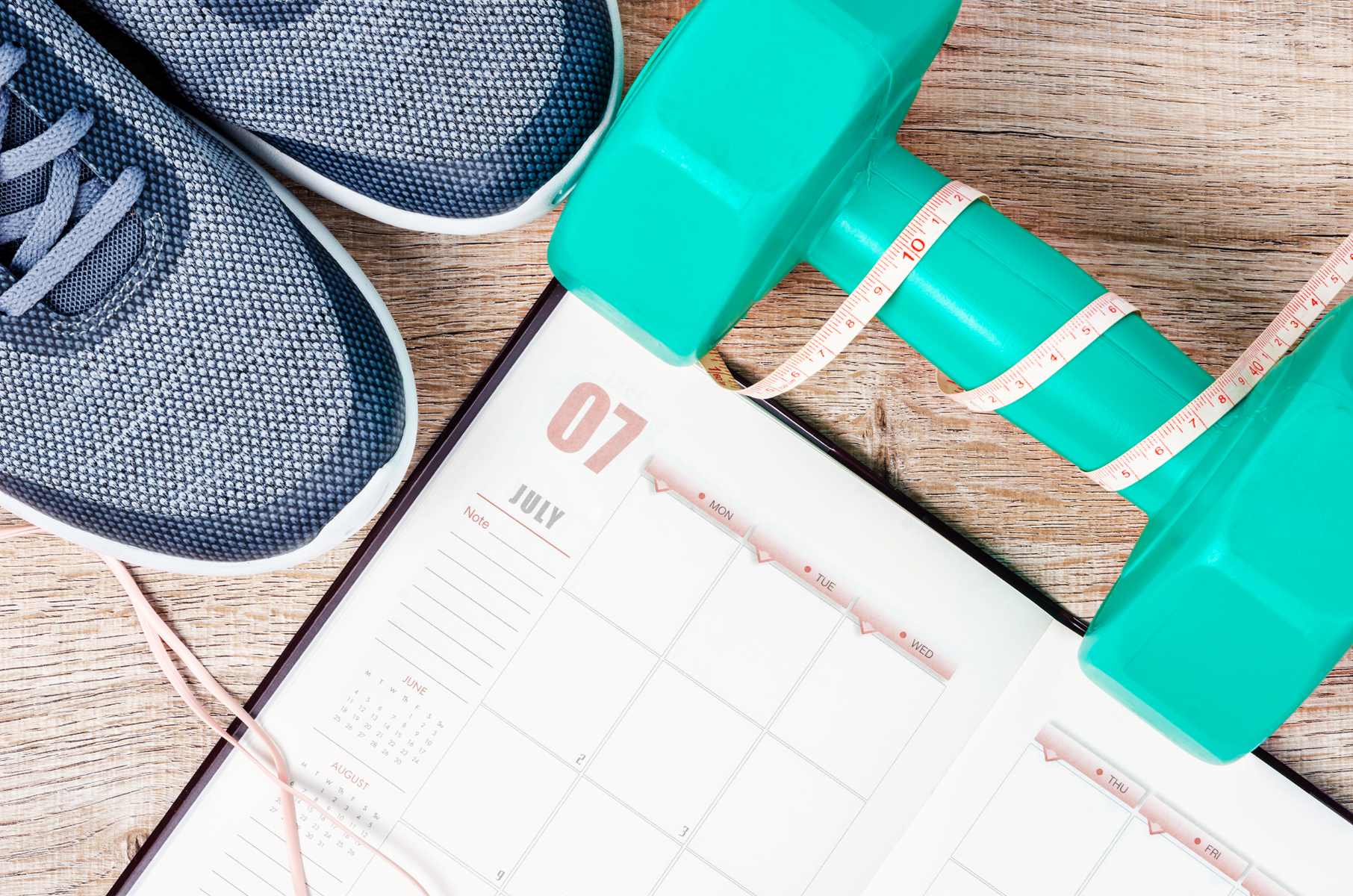

Featured
How Much Exercise Should You Do Each Day
Published: October 7, 2023
Get expert advice on the recommended amount of exercise you should aim for each day. Discover why being featured in your fitness routine is essential for optimal health.
Introduction
Physical activity is essential for maintaining good health and overall well-being. Engaging in regular exercise has numerous benefits, both physically and mentally. It can enhance cardiovascular health, strengthen muscles and bones, improve mood, reduce the risk of chronic diseases, and boost energy levels.
However, with our increasingly sedentary lifestyles and busy schedules, it can be challenging to find the time and motivation to exercise consistently. Many people wonder how much exercise they should aim for each day to reap the maximum benefits without overexerting themselves.
In this article, we will delve into the recommended guidelines for daily exercise and explore the factors that determine the appropriate amount of physical activity for different age groups. Additionally, we will discuss the advantages of regular exercise and the potential risks of not getting enough activity. Finally, we will offer some tips on finding the right balance and incorporating exercise into your daily routine.
Whether you are a fitness enthusiast or someone just starting their journey towards a healthier lifestyle, understanding how much exercise you should get a day is a crucial component in achieving your fitness goals and improving your overall well-being. So, let’s dive in and discover the world of daily exercise and its benefits!
Why Daily Exercise is Important
Regular physical activity is vital for maintaining optimal health. Engaging in daily exercise has a multitude of benefits that encompass both the physical and mental aspects of well-being. Let’s explore why incorporating exercise into your daily routine is so crucial:
1. Boosts Physical Health: Engaging in regular exercise can improve cardiovascular health by strengthening the heart and enhancing blood circulation. It also helps in maintaining a healthy weight, reducing the risk of obesity, and improving metabolism. Exercise is also beneficial for strengthening muscles and bones, reducing the likelihood of developing osteoporosis, and improving overall physical fitness.
2. Enhances Mental Well-being: Exercise has numerous psychological benefits. It increases the production of endorphins, often referred to as the “feel-good” hormones, which help reduce stress, anxiety, and symptoms of depression. Regular physical activity also improves cognitive function, enhances memory and concentration, and promotes better sleep quality.
3. Reduces the Risk of Chronic Diseases: Leading an active lifestyle can significantly lower the risk of developing chronic diseases. Regular exercise has been associated with a decreased likelihood of developing conditions such as heart disease, type 2 diabetes, certain types of cancer, and high blood pressure. It also helps in managing chronic conditions like arthritis, reducing pain and stiffness.
4. Increases Energy Levels: Contrary to popular belief, engaging in physical activity actually boosts energy levels rather than depleting them. Regular exercise improves blood flow and oxygen delivery to the body’s tissues, resulting in increased energy levels and improved endurance throughout the day.
5. Improves Mood and Mental Health: Exercise has a significant impact on mental well-being. Physical activity stimulates the release of endorphins, which are natural mood boosters. It helps in reducing symptoms of stress, anxiety, and depression, promoting a more positive and balanced mental state.
6. Enhances Quality of Sleep: Regular exercise has been shown to improve sleep quality. Physical activity helps in reducing the time it takes to fall asleep and improves sleep duration and efficiency. Getting an adequate amount of restful sleep is essential for overall health and well-being.
In summary, daily exercise is crucial for maintaining good health, both physically and mentally. It boosts physical fitness, enhances mental well-being, reduces the risk of chronic diseases, increases energy levels, improves mood, and enhances sleep quality. By incorporating regular exercise into your lifestyle, you can experience these benefits and enjoy a healthier, happier life.
Factors to Consider
When determining how much exercise you should get in a day, there are several factors to consider. It’s important to understand that everyone’s needs may vary based on individual circumstances, goals, and overall health. Here are some key factors to take into account:
1. Age: Age plays a significant role in determining the appropriate amount of exercise. Children and adolescents typically require at least 60 minutes of moderate to vigorous physical activity each day. Adults, on the other hand, should aim for at least 150 minutes of moderate-intensity exercise or 75 minutes of vigorous-intensity activity per week.
2. Fitness Level: Your current fitness level is another crucial factor to consider. Beginners should start slowly and gradually increase the intensity and duration of their workouts. Those who are already physically active may require more exercise to continue challenging their bodies and making progress.
3. Health Conditions: If you have any underlying health conditions or injuries, it’s important to consult with a healthcare professional or a certified fitness expert. They can provide guidance and tailor an exercise plan that takes into account your specific needs, ensuring you engage in activities that are safe and suitable for your condition.
4. Goals and Objectives: Your fitness goals and objectives will also influence the amount of exercise you should aim for. If your goal is weight loss, you may need to increase the duration and intensity of your workouts. If you’re training for a specific event or sport, it’s important to incorporate exercises that will improve your performance in that particular activity.
5. Lifestyle Factors: Your lifestyle and daily schedule will play a role in determining how much exercise you can realistically fit into your day. Consider factors such as work commitments, family responsibilities, and other time constraints to find a balance that works for you. Remember, even short bursts of physical activity throughout the day can add up and provide significant health benefits.
6. Personal Preferences: Lastly, consider your personal preferences when choosing the type of exercise you enjoy. If you don’t enjoy a particular activity, you’re less likely to stick with it. Find activities that you find enjoyable, whether it’s swimming, cycling, dancing, or playing a sport, so that you stay motivated and make exercise a regular part of your routine.
By considering these factors, you can determine the appropriate amount of exercise that aligns with your age, fitness level, health conditions, goals, lifestyle, and personal preferences. Remember, it’s essential to listen to your body and make adjustments as needed to ensure a safe and effective exercise routine.
Guidelines for Different Age Groups
The recommended guidelines for daily exercise vary depending on age. Here, we outline the general recommendations for different age groups:
1. Children and Adolescents: Children and adolescents should engage in at least 60 minutes of moderate to vigorous physical activity every day. This can include activities such as running, biking, swimming, playing sports, or participating in organized physical education classes. It’s important to encourage a variety of activities to promote overall fitness, strength, and coordination.
2. Adults (18-64 years): For adults, the general guideline is to aim for at least 150 minutes of moderate-intensity aerobic exercise or 75 minutes of vigorous-intensity aerobic exercise per week. Alongside aerobic activity, adults should also engage in muscle-strengthening activities that target major muscle groups at least two days a week. This can include weightlifting, bodyweight exercises, or using resistance bands.
3. Older Adults (65+ years): Older adults should aim for the same amount of exercise as adults (150 minutes of moderate-intensity or 75 minutes of vigorous-intensity aerobic activity per week). Additionally, they should incorporate activities that improve balance and flexibility, such as yoga or tai chi, to reduce the risk of falls and maintain mobility. It’s important to consult with a healthcare professional to ensure safety and tailor an exercise plan that fits individual needs.
While these guidelines provide a general framework, it’s important to remember that individual needs and abilities can vary. It’s crucial to listen to your body, start at your fitness level, and gradually increase the intensity and duration of your workouts. If you have any health conditions or concerns, it’s advisable to consult with a healthcare professional or a certified fitness expert before starting any new exercise program.
Incorporating daily exercise into our lives is important for people of all ages. By following the recommended guidelines and adjusting them to our individual circumstances, we can maintain good health, improve overall fitness, and enhance our quality of life.
Benefits of Regular Exercise
Engaging in regular exercise brings numerous benefits to our physical and mental well-being. Here are some of the key benefits of making exercise a regular part of your routine:
1. Improved Cardiovascular Health: Regular exercise strengthens the heart, improves blood circulation, and lowers blood pressure, reducing the risk of cardiovascular diseases. It also increases the levels of HDL (good) cholesterol while decreasing the levels of LDL (bad) cholesterol and triglycerides.
2. Weight Management: Exercise helps in controlling body weight by burning calories. It increases metabolism, builds lean muscle mass, and reduces body fat. Regular physical activity, combined with a healthy diet, is essential for achieving and maintaining a healthy weight.
3. Enhanced Mental Well-being: Exercise is a powerful mood booster. It stimulates the release of endorphins, which are natural chemicals that create feelings of happiness and reduce feelings of stress, anxiety, and depression. Regular exercise also improves cognitive function, memory, and overall mental alertness.
4. Increased Strength and Flexibility: Regular strength training builds muscle strength and endurance, promoting overall physical fitness and reducing the risk of injury. Incorporating flexibility exercises, such as stretching or yoga, into your routine improves joint mobility and prevents muscle imbalances.
5. Better Sleep Quality: Exercise is associated with improved sleep quality. Physical activity helps regulate the sleep-wake cycle, promotes relaxation, and reduces insomnia. A good night’s sleep is essential for overall health and well-being.
6. Reduced Risk of Chronic Diseases: Regular exercise lowers the risk of developing chronic conditions such as heart disease, type 2 diabetes, certain types of cancer, and osteoporosis. It also helps in managing existing chronic conditions, reducing symptoms and improving quality of life.
7. Increased Energy and Stamina: Regular physical activity improves cardiovascular fitness, increases oxygen supply to the body’s tissues, and enhances energy levels and stamina throughout the day. Exercise also promotes better digestion, making you feel more energized and refreshed.
8. Social Engagement: Many forms of exercise, such as group fitness classes, team sports, or outdoor activities, provide opportunities for social interaction and connection. This can boost mood, motivation, and overall well-being.
By incorporating regular exercise into your lifestyle, you can experience these remarkable benefits. Physical activity not only improves your physical health but also positively impacts your mental and emotional well-being. So, lace up your sneakers, find activities you enjoy, and make exercising a regular part of your life!
Risks of Not Getting Enough Exercise
Living a sedentary lifestyle and not getting enough exercise can have significant negative impacts on our health and well-being. Here are some of the risks associated with not engaging in regular physical activity:
1. Weight Gain and Obesity: Lack of exercise can contribute to weight gain and obesity. When we are sedentary, we burn fewer calories, and unused energy is stored as fat. This can lead to an increase in body weight and body mass index (BMI), increasing the risk of obesity-related health conditions like heart disease, diabetes, and certain types of cancer.
2. Poor Cardiovascular Health: Not getting enough exercise can weaken the heart muscle, leading to poor cardiovascular health. The lack of physical activity increases the risk of high blood pressure, high cholesterol levels, and the development of arterial plaque, which can lead to heart disease and stroke.
3. Muscle Weakness and Loss of Bone Density: Without regular exercise, muscles can become weak and lose mass, compromising strength and mobility. Lack of exercise also contributes to a decrease in bone density, increasing the risk of osteoporosis in later life.
4. Increased Risk of Chronic Diseases: Sedentary behavior is associated with an increased risk of developing chronic diseases such as type 2 diabetes, certain types of cancer (e.g., colon, breast), and metabolic syndrome. Lack of physical activity affects insulin sensitivity, hormonal balance, and overall metabolic function.
5. Mental Health Issues: Not getting enough exercise can have negative implications for mental health. Physical activity promotes the release of endorphins, which help reduce stress, anxiety, and symptoms of depression. Without regular exercise, individuals may experience higher levels of stress, poor mood regulation, and a higher risk of developing mental health disorders.
6. Decreased Energy Levels: A sedentary lifestyle contributes to reduced energy levels. Without regular physical activity, the body’s oxygen and nutrient delivery mechanisms become less efficient, leading to lower energy levels and increased feelings of fatigue and lethargy.
7. Impaired Sleep Quality: Lack of exercise can negatively impact sleep patterns. Regular physical activity promotes better sleep by enhancing sleep quality and reducing the time it takes to fall asleep. Without exercise, individuals may experience difficulties falling asleep, wake up frequently during the night, or suffer from overall poor sleep quality.
8. Reduced Quality of Life: Not getting enough exercise can significantly impact overall quality of life. Physical activity increases mobility, flexibility, and functional capacity, allowing individuals to engage fully in daily activities and maintain independence. Without regular exercise, impairments in physical function and overall well-being may occur.
It is important to recognize the risks associated with a sedentary lifestyle and prioritize regular physical activity to maintain optimal health and well-being. By incorporating exercise into your daily routine, you can mitigate these risks and improve your overall quality of life.
Finding the Right Balance
Finding the right balance when it comes to exercise is crucial for both physical health and overall well-being. Here are some tips to help you strike that balance:
1. Set Realistic Goals: Start by setting realistic and attainable exercise goals. Consider your current fitness level, schedule, and commitments. Gradually increase the intensity, duration, and frequency of your workouts as you progress.
2. Listen to Your Body: Pay attention to how your body feels before, during, and after exercise. It’s important to challenge yourself, but not to the point of exhaustion or pain. If you experience any discomfort or signs of overexertion, take a break and modify your workout routine accordingly.
3. Mix Up Your Routine: Keep your exercise routine exciting and prevent boredom by incorporating a variety of activities. This could include aerobic exercises like running or cycling, strength training, yoga, dancing, or sports. Mixing up your routine not only keeps you engaged but also works different muscle groups and boosts overall fitness.
4. Prioritize Rest and Recovery: Rest and recovery are essential components of a balanced exercise routine. Allow your body time to recover and repair itself. Rest days help prevent overuse injuries and ensure that you have enough energy for your next workout.
5. Make It Enjoyable: Choose activities that you genuinely enjoy. It could be taking a dance class, playing a sport, hiking, or simply going for a walk in nature. When you enjoy what you’re doing, exercise becomes something to look forward to, making it easier to incorporate into your daily life.
6. Incorporate Movement Throughout the Day: It’s not just about the dedicated workout sessions. Look for opportunities to incorporate movement throughout your day. Take the stairs instead of the elevator, walk or bike to nearby destinations, or take short breaks to stretch and move during prolonged periods of sitting.
7. Find an Accountability Partner: Having someone to exercise with or someone to hold you accountable can provide motivation and make the process more enjoyable. Join a fitness class, find a workout buddy, or consider hiring a personal trainer to help you stay on track.
8. Listen to Your Preferences: Lastly, find activities that align with your preferences and lifestyle. If you’re not a fan of traditional gym workouts, explore alternative options like swimming, dancing, or team sports. The more you enjoy the activities, the more likely you are to stick with them.
Finding the right balance with exercise is about creating a routine that fits your unique needs, preferences, and goals. It’s not about pushing yourself to extreme limits or adhering to a one-size-fits-all approach. By following these tips and understanding your own body’s signals, you can maintain a balanced exercise routine that supports your overall health and well-being.
Conclusion
Daily exercise plays a vital role in maintaining optimal health and well-being. By understanding the recommended guidelines for different age groups and considering factors such as age, fitness level, and personal preferences, you can determine the appropriate amount of exercise for yourself. Regular exercise brings numerous benefits, including improved cardiovascular health, weight management, enhanced mental well-being, increased strength and flexibility, reduced risk of chronic diseases, increased energy levels, and improved social engagement.
On the other hand, not getting enough exercise poses risks such as weight gain, poor cardiovascular health, muscle weakness, increased risk of chronic diseases, impaired mental health, decreased energy levels, and reduced quality of life. It is important to find the right balance, set realistic goals, listen to your body, and prioritize both exercise and rest. By incorporating enjoyable activities, finding accountability partners, and incorporating movement throughout the day, you can create a sustainable exercise routine that works for you.
Remember, exercise is not a one-size-fits-all approach. It is essential to customize your routine based on your individual needs and goals. Consult with healthcare professionals or fitness experts if you have any underlying health conditions or concerns. By making exercise a regular part of your life and finding the right balance, you can optimize your health, improve your overall well-being, and enjoy the countless benefits that come with staying active.








